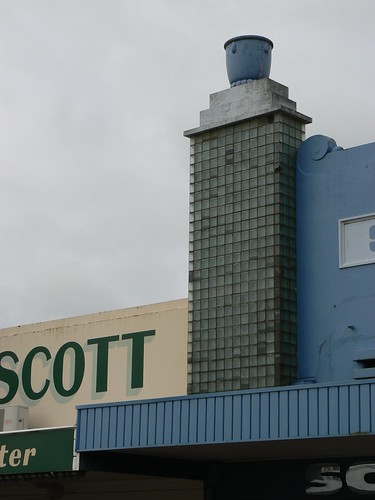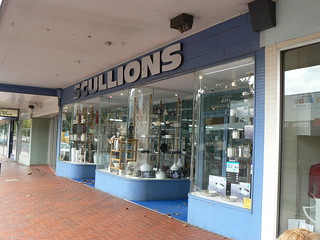Just what did the people of Hamilton, a fairly major town in the rural Western District of Victoria, think when Melbourne architects, Seabrook & Fildes, proposed this amazing shopfront for their main shopping strip in Gray Street. It was 1938, or perhaps a little before that, and Seabrook & Fildes, who were very active in Hamilton in the interwar period, used one of their favourite motifs, a glass brick tower.Around the same time they had also included a glass brick tower as part of their alterations to the George Hotel, a bit further along Gray Street. To counterbalance the tower, the other side of the building featured a pair of Art Deco bands curving down towards the verandah.At street level, the shopfront featured lovely curved glass display windows.References:
Victorian Heritage Database, Scullion's, Hamilton
Victorian Heritage Database, The George Hotel, Hamilton
Monday, December 16, 2013
Subscribe to:
Post Comments (Atom)











































.jpg)















Love this building but that is a weird pot on the roofline. They got a lot of work in Hamilton from Reg Ansett who had gone to school with Fildes
ReplyDeleteThanks Robin! I knew there was a link between Fildes and Hamilton but I couldn't find the reference.
DeleteStunning architecture, it sure is my favourite one along the other styles between 20s and 40s. Here in Constanta, Romania we have a very large number of art deco buildings. from small residential villas to apartment buildings, schools, hospitals and other public buildings. Imust say that the things i like the most about the buildings are the doors.
ReplyDeleteArt Deco really is the most remarkable 'international style'. I am not surprised in the least when people report that there are a lot of Art Deco buildings in xxx. In the meantime another place gets added to the Deco Travel Wish List.
DeleteAfter the Turkis Russian war Constanta was almost wiped out. It had nearly 100 people. So the turk sultan rented the entire today's old city to british companies so the british build the city: over 200 buildings, railway, the seaport etc. After 1900 when Romania takes over the Dobrudgea Region the number of the british companies and the us companies grew so of course they influenced the local architecture. I've just started a blog that i'll hope to make the hub for the old city. I have a special section dedicated to the local art deco. Some of the buildings resemble New York Style art deco and some Miami Style of art deco.
Deletehere is one of the most well rpeserved buildings is this hotel:
[IM]http://2.bp.blogspot.com/-1s6igGkzemI/UjY33oZbifI/AAAAAAAAovE/PFcgRxJqqpk/s1600/ferdinand.jpg[/IM]
Very nice building!
DeleteHere is the link to my art deco section
Deletehttp://constantaoldcity.blogspot.ro/search/label/art-deco
at the bottom of the page is a translate button. I'll hope that maybe someday you'll come and visit Constanta.
Meanwhile i'm spending my time here on your blog admiring the beauty of deco from all arround the world. I'm so glad i've found your blog :D btw sorry for my english it's not my first language.
Thank you and your English is very good. Much better than my Romanian.
DeleteYou blog looks good. I look forward to seeing some more of you deco posts.
The curved bands going down to the verandah still look in excellent condition but the glass tower, which must have once been stunning, needs attention urgently. Was blue the original colour?
ReplyDeleteNo doubt the glass tower has seen better days. Looking at the photo on the Heritage Victoria site, the building looks white or cream. I don't know if that's the original colour but it's certainly more likely than this blue.
DeleteIn the 1950s, the colour of the tiles on the lower part of the front of this building was shigh-gloss black, and the lettering on the windows and signs was silver. For many years it was Andre Beauty Salon. (I lived in Hamilton 1952-1966).
ReplyDelete